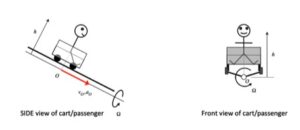| Problem statement Solution video |
DISCUSSION THREAD

Any questions?? Please ask/answer questions regarding this homework problem through the "Leave a Comment" link above.
| Problem statement Solution video |
DISCUSSION THREAD

Any questions?? Please ask/answer questions regarding this homework problem through the "Leave a Comment" link above.
Comments are closed.
What is the difference in solving for the acceleration vs the rate of change of velocity for the head?
There is no difference, but the problem asks us to find "the magnitude of acceleration and the rate of change of speed of the passenger’s head". The rate of change of speed is v_dot, or the component of acceleration in the tangential direction, whereas the magnitude of acceleration takes into account both v_dot and the component of acceleration in the normal direction. Therefore, these two quantities are different if there is a nonzero component of acceleration in the normal direction.
The problem statement says that the cart moves with a speed of v_O and a_O. I believe a_O is actually the magnitude of the acceleration of point O.
I believe the velocity of the head will be more than V (o), as seen in the in-class example. My calculations suggest otherwise because omega is in +k and r(o to a) in j, suggesting -i hat. Am I doing something wrong?
It depends how you are defining your coordinate system. I defined my x-direction as along the track and my y-direction as the direction h is in. This meant, by the right-hand rule, that the z-direction was coming out of the page in the side view or to the left in the front view.
Looking at the side and front view, assuming that the x-direction is along the track (the direction O travels in), then omega is in the +x direction, not the +k direction.
To find the rate of change of the speed of the passenger's head, is it accurate to say that:
v_dot = a_head dotted with e_t,
where e_t is the tangential unit vector, e_t = v_head/|v_head|?
Yes, that is correct.
When solving for v_dot here, take care when calculating the dot product of a_head and e_t. Specifically, the components of each of these vectors.
Choosing a coordinate system is important when setting up this problem. I like to use cartesian as much as possible because it makes more sense intuitively in my head. For this problem, I chose to make the positive i direction down the track and the positive j direction in the direction from point O to the passenger's head.
Should our velocity vector be in 3 dimensions? If so and we do it in terms of e_t and e_n what do we need to convert back to cartesian?
Despite omega being constant, you cannot assume that the rotation does not contribute towards the head's acceleration. Use the rigid body kinematics equations for acceleration and you will understand.
Since Vo, Ao, and the spiral from omega all seem to point in the same direction does this mean that if we were to denote along the track as our positive i vector, that our omega would also be in this same i direction?
Yes, according to right hand rule, the omega is in the counter clockwise direction facing the k^ vector, which gives it a value of 2 rad/s in the positive i^ vector.
Remember that the rate of change of speed is different than acceleration. Rate of change of speed is v_dot. Remember that the equation for v_dot = a (vector) in a dot product with e_t, and e_t is v (vector) divided by the magnitude of that vector.
for part b, to find Vdot, you need to first find the unit vector for velocity. you can simply do that by dividing velocity vector with its magnitude. then use Vdot = unit vector . acceleration vector. (careful for the i,j,k dot rule). Hope that helps!
unit vector dot itself = 1
unit vector dot perpendicular unit vector = 0 since no projection
Notice when you do right hand rule that omega is not in the k direction. Ensure that you put omega in the correct vector direction.